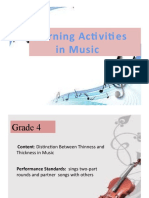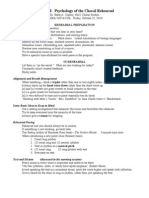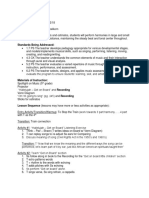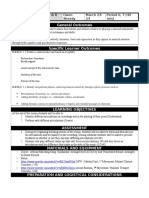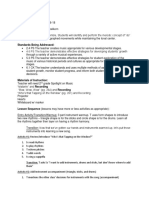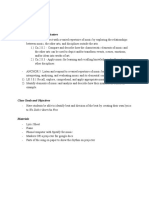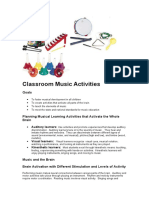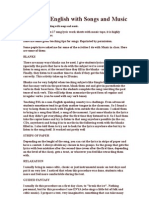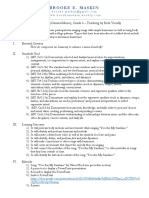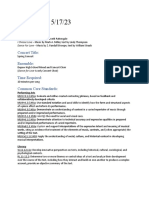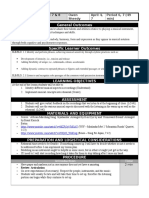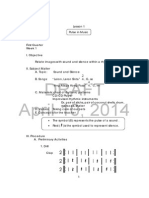Lesson 2 Notes PDF
Lesson 2 Notes PDF
Uploaded by
AuxiliareCopyright:
Available Formats
Lesson 2 Notes PDF
Lesson 2 Notes PDF
Uploaded by
AuxiliareOriginal Title
Copyright
Available Formats
Share this document
Did you find this document useful?
Is this content inappropriate?
Copyright:
Available Formats
Lesson 2 Notes PDF
Lesson 2 Notes PDF
Uploaded by
AuxiliareCopyright:
Available Formats
I think over half the class should focus on singing and just touch on theory near the end or
beginning… we need to inform other bros and sis as well
Lesson 2 -
Practical Elements:
Pitch (2 mins)
-brief review of what was spoken of last class —> especially for those that didn’t stay
Warm up (10 min)
-stretches
-breathing —> tying back to last class about breathe —> “Ha Ha Ha”, P T K F Sh, Ts Ts Ts Ts
-sirens, sliding down reach a note, light arpeggio exercise ng, oo, ah, eh
-> Reminder: Tell Mel how I’d like the scales to be played
Games:
Up or Down?
-training recognition of pitch, higher or lower
Sing this note!
-play a note and have the group match it
Level 2 - play a note, have them listen and recognise it in their head, wait a while/speak to some/
make some noise/sing, have them sing back the note
Preliminary Harmony
1)Do Me So
2) sing a note, Shmelly sing a solo on top
3) Play the note they have to memorise, Shmelly sing first, choir add in after wards
Scales (2 min)
-brief review of scales, apples
Introduction of Intervals (leave this to Edmond)
-briefly why intervals are important? They help you sight read music —> an extremely important
skill to learn, but you don’t need to learn this now. But you need to get used to intervals
Introduction Songs —> may sit down to sing, but have them sit up and on the edge of their seats
-> play melody and have them “oo” it first, start with words
Song selections:
1) Give Thanks
2) Homeward bound (short excerpt)
3) You’re ideas are Welcomed Mel~~
Starting with English Songs first because it’s easier to grasp the vowels
Vowels
What are vowels? They create the basis of sound, composed of A E I O U. (I E A O U - ee, eh, ah
oh, oo) From back to the front of the mouth
Why are they important?
They sustain the note. Try singing a note with a consonant. (P), (F)
How you use vowels are important:
They help with the projection of the note, they add different colours to the piece and is SUPER
important in a choir setting because you want UNITY (mak kai).
Example:
3 student make 3 different Ah sounds. Then all make the same Ah sound
There are different ways to produce vowel sounds, you actually just heard it.
Wider ————————————— Longer it’s a sliding scale
Warmer Sadder
Less projection More projection
(more in your face)
Different styles of songs use different techniques
eg. Country Music uses more wider vowels where as opera uses longer vowels
if you switch the vowel styles you get really different feels (eg. blue song with wide vowels)
Question:
Do you know what type of vowel technique we will be using?
Longer Vowels
Why? Because as a choir 1) better projection (most choirs world wide don’t use mics, they use
pure voice. It’s the projection that gets them heard) 2) It’s better to blend
Why is blending so important?
What is a choir? It’s MANY voices becoming ONE voice. When choirs go into competitions, they
look for various elements, one is do they sound like one voice? is there a connection, unity,
togetherness.
Ideas for your Lesson 3 :D
Rhythm practical:
The songs that you learned last class, bring them up to sing again and have them
1) claps the rhythm of the piece and
2) speak the words in rhythm
Encourage them to pat their hands on their tights when singing or speaking a rhythm as to get
acquainted with the tempo
You might also like
- Perdido Teaching Guide FINALDocument7 pagesPerdido Teaching Guide FINALuq2No ratings yet
- RSL Drums Grade 1 - Compress PDFDocument18 pagesRSL Drums Grade 1 - Compress PDFesabo100% (3)
- Communicating Through Music Performance LessonDocument3 pagesCommunicating Through Music Performance Lessonapi-252313121No ratings yet
- Basic Music Theory For BeginnersDocument18 pagesBasic Music Theory For BeginnersJenna Marie Tolosa0% (1)
- Master Rehearsal Plan AmaniDocument4 pagesMaster Rehearsal Plan Amaniapi-242480548No ratings yet
- Ghalin Lotangan Vandin Charan AartiDocument1 pageGhalin Lotangan Vandin Charan AartiWheresMyPandit100% (1)
- 2017 MDiv Booklist PDFDocument32 pages2017 MDiv Booklist PDFMÍLLER GÓMEZ RUIZNo ratings yet
- Everyday Literacy Listening and Speaking, Grade PreKDocument182 pagesEveryday Literacy Listening and Speaking, Grade PreKEkaterina Shubina100% (5)
- Grade 1Document25 pagesGrade 1123owenNo ratings yet
- Music Powerpoint Notes FInalDocument28 pagesMusic Powerpoint Notes FInalwasser36No ratings yet
- Concepts of Music Work BookDocument5 pagesConcepts of Music Work BookJosephineGleesonNo ratings yet
- Year 10 Film MUSIC UNIT Cashmere High School Teacher: Grant BartleyDocument8 pagesYear 10 Film MUSIC UNIT Cashmere High School Teacher: Grant BartleySeraLevingsNo ratings yet
- MusicDocument12 pagesMusicgalletoreamay567No ratings yet
- MUSIC 4 Session Guide As of April 1, 2015 PDFDocument5 pagesMUSIC 4 Session Guide As of April 1, 2015 PDFLemuel KimNo ratings yet
- FolktoshapenoteDocument14 pagesFolktoshapenoteapi-318236959No ratings yet
- HarmonyunitDocument7 pagesHarmonyunitapi-742597679No ratings yet
- Beginning Band Rehearsal TechniquesDocument37 pagesBeginning Band Rehearsal TechniquesBrianna Williams100% (1)
- SecondaryunitfinalDocument11 pagesSecondaryunitfinalapi-439220457No ratings yet
- "It's All in The BAG" Recorder RoundDocument3 pages"It's All in The BAG" Recorder Rounddl1485No ratings yet
- Learning Acti Viti Es in MusicDocument21 pagesLearning Acti Viti Es in MusicEva Mae DumagilNo ratings yet
- Mu101 Final Unit ProjectDocument17 pagesMu101 Final Unit Projectapi-298614699No ratings yet
- Session Guide Dynamics and TimbreDocument13 pagesSession Guide Dynamics and TimbreNhey CawiganNo ratings yet
- WorkshopproposalDocument2 pagesWorkshopproposalapi-242888283No ratings yet
- Grade 2Document24 pagesGrade 2123owen100% (1)
- Copley Conducting Workshop HandoutDocument4 pagesCopley Conducting Workshop HandoutHouston NielNo ratings yet
- Uniting Orff and Kodaly Resource PacketDocument53 pagesUniting Orff and Kodaly Resource Packetcaneti100% (4)
- 5th Grade Lesson 2-12-18Document2 pages5th Grade Lesson 2-12-18api-357689913No ratings yet
- SH Choir - March 29Document2 pagesSH Choir - March 29api-299316534No ratings yet
- General Outcomes: Class: #2 Grade 7 & 8 Band Owen Sheedy March 23-24 Period 6, 7 (49 Min) Playing: ReadingDocument3 pagesGeneral Outcomes: Class: #2 Grade 7 & 8 Band Owen Sheedy March 23-24 Period 6, 7 (49 Min) Playing: Readingapi-301728453No ratings yet
- Grade 1 Unit 2 UBD With Stage 3Document13 pagesGrade 1 Unit 2 UBD With Stage 3John FritzNo ratings yet
- Chorale 101: Part 1: VoiceDocument1 pageChorale 101: Part 1: VoiceJohn Edward AmarNo ratings yet
- Kodaly Folk Song Analysis Bought Me A CatDocument5 pagesKodaly Folk Song Analysis Bought Me A Catapi-405740738No ratings yet
- On Teaching Harmony and TextureDocument6 pagesOn Teaching Harmony and TexturenuraffiyahgabrielNo ratings yet
- FULL Lesson Plan For 2-16-18 Teacher Name: Michael Fibelkorn ObjectivesDocument2 pagesFULL Lesson Plan For 2-16-18 Teacher Name: Michael Fibelkorn Objectivesapi-357689913No ratings yet
- Uniting Orff and Kodaly Resource PacketDocument53 pagesUniting Orff and Kodaly Resource PacketRyanMPeters100% (1)
- FINAL LESSON PLAN For DEMODocument5 pagesFINAL LESSON PLAN For DEMOAlgelyn FuentesNo ratings yet
- Lesson Planning ProjectDocument7 pagesLesson Planning Projectapi-455363853No ratings yet
- Classroom Music Activities: GoalsDocument9 pagesClassroom Music Activities: GoalsHarlyn May Geriane100% (1)
- DanielperezkevinseguraDocument1 pageDanielperezkevinseguraapi-198345293No ratings yet
- MusicdlpDocument3 pagesMusicdlpLeshane BadicNo ratings yet
- Activities Suggestions - Teaching English With Songs and MusicDocument4 pagesActivities Suggestions - Teaching English With Songs and MusicEugenio Mondejar100% (1)
- Lesson Plan General Music Grade 6 - Teaching by RoteDocument5 pagesLesson Plan General Music Grade 6 - Teaching by Roteapi-494885256No ratings yet
- +UNIT - 17 SummaryDocument6 pages+UNIT - 17 SummaryTamara Valdés SerranoNo ratings yet
- Elementary Unit-LP 9 Hunt The Cows PracticeDocument5 pagesElementary Unit-LP 9 Hunt The Cows PracticeKathryn Haffner Tremblay100% (1)
- Detailed Lesson Plan in MusicDocument13 pagesDetailed Lesson Plan in MusicDaryl Gaoiran SolivenNo ratings yet
- Annie's Final Rehearsal OutlineDocument3 pagesAnnie's Final Rehearsal OutlineAnnie McCuneNo ratings yet
- Workshop Notes: Dalcroze For TheatreDocument4 pagesWorkshop Notes: Dalcroze For TheatrepapuenteNo ratings yet
- Choir Lesson Plan 5 17 23Document3 pagesChoir Lesson Plan 5 17 23api-670720257100% (1)
- My Choir - March 29Document2 pagesMy Choir - March 29api-299316534No ratings yet
- Chrisa Kitsiou, Music Theory - Solfège, Developing Aural Skills - Book 1From EverandChrisa Kitsiou, Music Theory - Solfège, Developing Aural Skills - Book 1No ratings yet
- Elements of MusicDocument4 pagesElements of MusicSam Milca NabelonNo ratings yet
- General Outcomes: Class: #3 Grade 7 & 8 Band Owen Sheedy April 4, 7 Period 6, 7 (49 Min) Playing: ReadingDocument3 pagesGeneral Outcomes: Class: #3 Grade 7 & 8 Band Owen Sheedy April 4, 7 Period 6, 7 (49 Min) Playing: Readingapi-301728453No ratings yet
- Piano CompositionsDocument66 pagesPiano CompositionsMary LinNo ratings yet
- Drum ImprovDocument3 pagesDrum Improvdl1485No ratings yet
- Preschool MusicDocument19 pagesPreschool Musicapi-356799616100% (3)
- Part 5 - Grade 10 Edumate - Singing in HarmonyDocument5 pagesPart 5 - Grade 10 Edumate - Singing in HarmonyAndrewOribianaNo ratings yet
- 1º ESOMusica ExamenDocument13 pages1º ESOMusica ExamenRey MoroNo ratings yet
- Music 3 TG Draft 4.10.2014Document189 pagesMusic 3 TG Draft 4.10.2014Jam MolinaNo ratings yet
- Scholarship Preparation 2021Document4 pagesScholarship Preparation 2021aayyll1810No ratings yet
- Songwriting Guide Prompt SheetsDocument5 pagesSongwriting Guide Prompt Sheetsandyedwards7350% (2)
- Middle School Impact ProjectDocument10 pagesMiddle School Impact Projectapi-300690811No ratings yet
- 2024 Individual Research Task1Document5 pages2024 Individual Research Task1eates2024No ratings yet
- Grade Three Unit Plan: Remembrance, Peace, Love, Friendship - November 2016 - 6 ClassesDocument3 pagesGrade Three Unit Plan: Remembrance, Peace, Love, Friendship - November 2016 - 6 Classesapi-300216638No ratings yet
- Intro to Music Theory: The Nuts and Bolts of MusicFrom EverandIntro to Music Theory: The Nuts and Bolts of MusicRating: 5 out of 5 stars5/5 (1)
- Laser-Scanning Workflow With Recap For Power-Stations Renovation ProjectsDocument15 pagesLaser-Scanning Workflow With Recap For Power-Stations Renovation ProjectsErnie ErnieNo ratings yet
- 2017 Music Catalog ClassifiedDocument297 pages2017 Music Catalog ClassifiedMiguel Jhosue SalasNo ratings yet
- Values:: Grade 8 - Arts Date: January 8, 2018 I. ObjectiveDocument2 pagesValues:: Grade 8 - Arts Date: January 8, 2018 I. ObjectivespenceryffarNo ratings yet
- MessageDocument3 pagesMessageY HNo ratings yet
- Osslt Practice Test Booklet1 Question PDFDocument12 pagesOsslt Practice Test Booklet1 Question PDFGabby ChuNo ratings yet
- Yoga Temple Picture Courtesy of Wwwharbinorgebqwp PDFDocument2 pagesYoga Temple Picture Courtesy of Wwwharbinorgebqwp PDFwinecoffee23No ratings yet
- DLF Capital Greens - Minsteer RealtyDocument14 pagesDLF Capital Greens - Minsteer RealtyAshita DharNo ratings yet
- Primo Theory: Level 3Document52 pagesPrimo Theory: Level 3msmali100% (1)
- Module 3Document21 pagesModule 3Ali Faizan100% (1)
- Simple Past Tense The Elves and The Shoemaker Short-Story-Learnenglishteam - ComDocument1 pageSimple Past Tense The Elves and The Shoemaker Short-Story-Learnenglishteam - ComgokagokaNo ratings yet
- The SupremesDocument12 pagesThe Supremesdon100% (1)
- Christian Kabbalah ArticleDocument4 pagesChristian Kabbalah ArticleBilly PhillipsNo ratings yet
- The Mark MasterDocument10 pagesThe Mark MastergustavojuriNo ratings yet
- Geoffrey ChaucerDocument2 pagesGeoffrey ChaucerPeKyu100% (1)
- Saturday Volcano Art: Fernando Amorsolo, Planting Rice With Mayon Volcano' (1949)Document2 pagesSaturday Volcano Art: Fernando Amorsolo, Planting Rice With Mayon Volcano' (1949)Luck Velasco100% (3)
- The Pivotal Role of Epistemology Within PhilosophyDocument4 pagesThe Pivotal Role of Epistemology Within PhilosophyNidia NurfebriyantiNo ratings yet
- Let's Talk About PetsDocument1 pageLet's Talk About PetsAmy BerezowskiNo ratings yet
- User Guide: Publish 3D For 3dexperienceDocument40 pagesUser Guide: Publish 3D For 3dexperienceVaibhav JagtapNo ratings yet
- The Fruitcake Special Project WorkDocument31 pagesThe Fruitcake Special Project WorkMiracle Hope100% (2)
- Artioscad Plug-Ins For Adobe Illustrator Release Notes October 16, 2006Document4 pagesArtioscad Plug-Ins For Adobe Illustrator Release Notes October 16, 2006roniNo ratings yet
- The Lightning ManDocument15 pagesThe Lightning ManAragan ThowficNo ratings yet
- Natal Chart Report: Site MenuDocument14 pagesNatal Chart Report: Site Menuvic chanNo ratings yet
- Nicomachean EthicsDocument42 pagesNicomachean EthicsPeter Paul RecaboNo ratings yet
- Notes On The in English: ZoharDocument36 pagesNotes On The in English: ZoharclausuberNo ratings yet
- LatheDocument130 pagesLatheAjay Sharma86% (7)
- A History of Zion Episcopal Church On The Occasion of Its L5Oth Anniversary Dobbs Ferry, New York 1833 - 1983Document12 pagesA History of Zion Episcopal Church On The Occasion of Its L5Oth Anniversary Dobbs Ferry, New York 1833 - 1983api-353055813No ratings yet



















